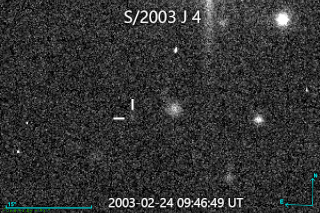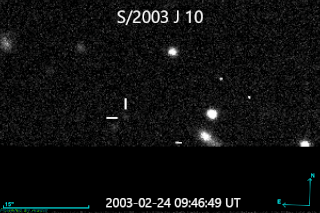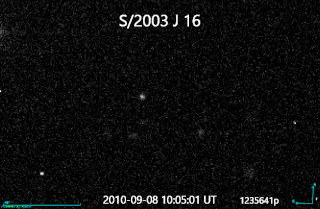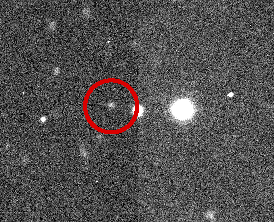Related Research Articles

S/2003 J 2 is a retrograde irregular satellite of Jupiter. The moon was discovered on 5 February 2003 by a team of astronomers from the University of Hawaii led by Scott S. Sheppard and David C. Jewitt, and was later announced on 4 March 2003. It was initially thought to be Jupiter's outermost known moon until recovery observations disproved this in 2020.

S/2003 J 4 is a natural satellite of Jupiter. It was discovered by a team of astronomers from the University of Hawaii led by Scott S. Sheppard in 2003.
Eirene, also Jupiter LVII and originally known as S/2003 J 5, is a retrograde irregular satellite of Jupiter. It was discovered by a team of astronomers from the University of Hawaii led by Scott S. Sheppard in 2003 but was then lost. It was recovered in 2017 and given its permanent designation that year.

S/2003 J 9 is a retrograde irregular satellite of Jupiter. It was discovered by a team of astronomers from the University of Hawaii led by Scott S. Sheppard in 2003.

S/2003 J 10 is a retrograde irregular satellite of Jupiter. It was discovered by a team of astronomers from the University of Hawaii led by Scott S. Sheppard et al. in 2003.

S/2003 J 12 is a natural satellite of Jupiter, and is one of the smallest known natural satellites in the Solar System. It was discovered by a team of astronomers from the University of Hawaii led by Scott S. Sheppard in 2003.
Philophrosyne, also Jupiter LVIII and provisionally known as S/2003 J 15, is a natural satellite of Jupiter. It was discovered by a team of astronomers from the University of Hawaii led by Scott S. Sheppard, et al. in 2003, but then lost. It was recovered in 2017 and given its permanent designation that year.

S/2003 J 16 is a natural satellite of Jupiter. It was discovered by a team of astronomers led by Brett J. Gladman in 2003.

Jupiter LV, provisionally known as S/2003 J 18, is a natural satellite of Jupiter. It was discovered by a team of astronomers led by Brett J. Gladman in 2003.
Jupiter LXI, provisionally known as S/2003 J 19, is a natural satellite of Jupiter. It was discovered by a team of astronomers led by Brett J. Gladman, et al. in 2003.

S/2003 J 23 is a natural satellite of Jupiter. It was discovered by a team of astronomers from the University of Hawaii led by Scott S. Sheppard et al. in 2004 from pictures taken in 2003.
S/2004 S 7 is a natural satellite of Saturn. Its discovery was announced by Scott S. Sheppard, David C. Jewitt, Jan Kleyna, and Brian G. Marsden on 4 May 2005 from observations taken between 12 December 2004 and 8 March 2005.
S/2004 S 12 is a natural satellite of Saturn. Its discovery was announced by Scott S. Sheppard, David C. Jewitt, Jan Kleyna, and Brian G. Marsden on 4 May 2005 from observations taken between 12 December 2004 and 9 March 2005.
S/2004 S 17 is a natural satellite of Saturn. Its discovery was announced by Scott S. Sheppard, David C. Jewitt, Jan Kleyna, and Brian G. Marsden on 4 May 2005 from observations taken between 13 December 2004 and 5 March 2005.
S/2004 S 13 is a natural satellite of Saturn. Its discovery was announced by Scott S. Sheppard, David C. Jewitt, Jan Kleyna, and Brian G. Marsden on 4 May 2005 from observations taken between 12 December 2004 and 9 March 2005.
S/2006 S 1 is a natural satellite of Saturn. Its discovery was announced by Scott S. Sheppard, David C. Jewitt, Jan Kleyna, and Brian G. Marsden on June 26, 2006 from observations taken between January 4 and April 30, 2006. S/2006 S 1 is about 6 kilometres in diameter, and orbits Saturn at an average distance of 18.65 Gm in 951.1 days, at an inclination of 154.6° to the ecliptic, in a retrograde direction and with an eccentricity of 0.0814.
S/2006 S 3 is a natural satellite of Saturn. Its discovery was announced by Scott S. Sheppard, David C. Jewitt, Jan Kleyna, and Brian G. Marsden on June 26, 2006 from observations taken between January and April 2006.
S/2007 S 2 is a natural satellite of Saturn. Its discovery was announced by Scott S. Sheppard, David C. Jewitt, Jan Kleyna, and Brian G. Marsden on May 1, 2007, from observations taken between January 18 and April 19, 2007. S/2007 S 2 is about 5 kilometres in diameter, and orbits Saturn at an average distance of 16,054,500 kilometres in 759.2 days, at an inclination of 176.65° to the ecliptic, in a retrograde direction and with an eccentricity of 0.237. According to Denk et al. (2018), it is presumably at high risk of colliding with Phoebe in the future.
Jupiter LXXII, originally known as S/2011 J 1, is a natural satellite of Jupiter. It was discovered by Scott Sheppard in 2011. It belongs to the Carme group.
Saturn LX, provisionally known as S/2004 S 29, is a natural satellite of Saturn and a member of the Gallic group. Its discovery was announced by Scott S. Sheppard, David C. Jewitt, and Jan Kleyna on October 7, 2019 from observations taken between December 12, 2004 and January 17, 2007. It was given its permanent designation in August 2021.
References
- ↑ Discovery Circumstances from JPL
- 1 2 3 4 "MPEC 2022-T125 : S/2007 S 3". Minor Planet Electronic Circular. Minor Planet Center. 12 October 2022. Retrieved 12 October 2022.
- 1 2 3 S.S. Sheppard (2019), Moons of Saturn, Carnegie Science, on line
- ↑ Jacobson, R.A. (2007) SAT272 (2007-06-28). "Planetary Satellite Mean Orbital Parameters". JPL/NASA. Archived from the original on 2011-08-10. Retrieved 2008-01-20.
{{cite web}}: CS1 maint: numeric names: authors list (link) - ↑ Jacobson, B.; Brozović, M.; Gladman, B.; Alexandersen, M.; Nicholson, P. D.; Veillet, C. (28 September 2012). "Irregular Satellites of the Outer Planets: Orbital Uncertainties and Astrometric Recoveries in 2009–2011". The Astronomical Journal. 144 (5): 132. Bibcode:2012AJ....144..132J. doi: 10.1088/0004-6256/144/5/132 . S2CID 123117568.
- Institute for Astronomy Saturn Satellite Data
- MPEC 2007-J09: S/2007 S 2, S/2007 S 3, 1 May 2007 (discovery and ephemeris)